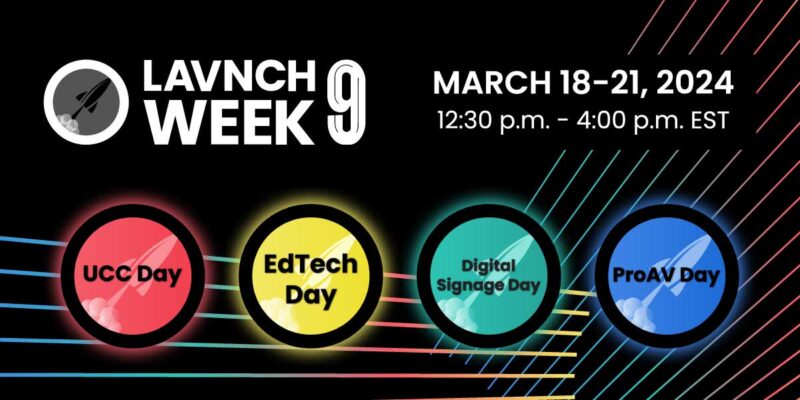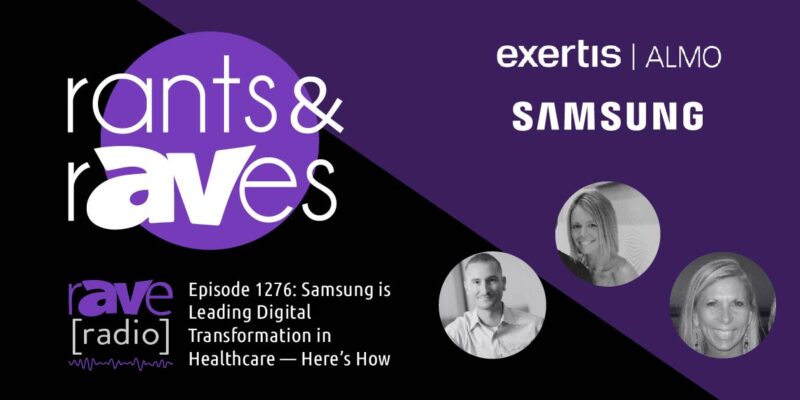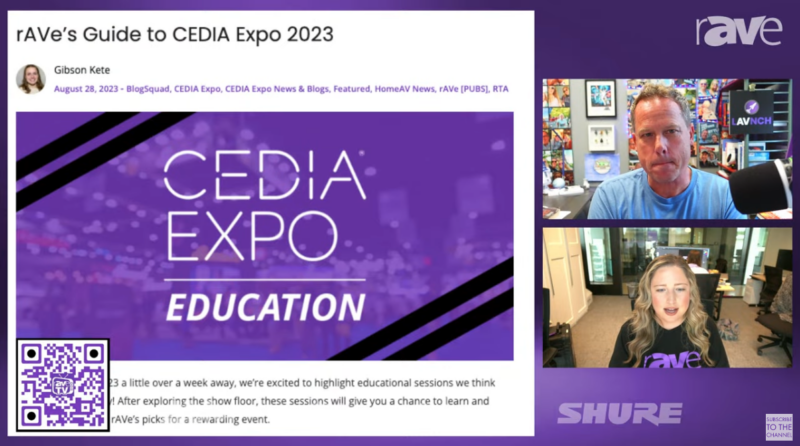SYNNEX VISUALSolv Healthcare Day: In Case You Missed It

Maybe you actually attended SYNNEX’s first-ever VISUALSolv Healthcare Day, part of the “SYNNEX VISUALSolv LAVNCH Days” series, yesterday — in which case you can ignore my headline. However, if you DID miss it, a day of virtual sessions focused exclusively on AV in healthcare, I give you this wrap-up.
Kicking off the event was SYNNEX’s own John Doar. After his warm welcome, we listened in on three great sessions (with all LIVE speakers and presentations), a public chat function and a “vendor toolkit” to round out the day.
We recapped some of the best parts and biggest takeaways for you below.
Keynote: Healthcare Trends and How They Relate to the World of AV
David Glenn is principal at The Sextant Group, a professional (and independent) design and consulting services firm. Glenn started the day with a keynote framing the conversation around current trends and ProAV’s potential response to these trends.
Each of these trends, Glenn noted, is intertwined:
- The patient experience. Patient experience is the ultimate goal, not only to patients but to the staff, providers and anyone in the healthcare ecosystem, really. “Optimizing” and “integrating” are key, Glenn added. Today, we’re asking, How do we integrate systems to provide that great user/patient experience? A challenge Glenn offers is that the patient experience expands well beyond the four walls of the hospital. What is the patient experience at home? What is it on a mobile or personal or wearable device? How is healthcare being delivered beyond the four walls of the healthcare office?
- Consumerization of healthcare. Healthcare systems have not been known, historically, for their agility, Glenn explained. Similar to what we look for in other verticals like online retail, etc., we (patients) will be looking for convenience and choice — like the healthcare version of getting a product delivered to your home within one hour, without ever having to leave your house. Healthcare systems need to change and keep pace with the new disruptors entering the market these last few years.
- COVID-19’s impact on acceleration of technology adoption. Glenn does not want to talk about a “post-pandemic world” but, rather, an already-shifted “normal.” Once we get past COVID-19, Glenn thinks we’ll look back at some of the technology adoption at this time — Zoom, what’s occurred in higher-ed and corporations overnight, etc. — as a catalyst for the future.
- Telemedicine. This one really advanced quickly, Glenn said. He thinks there will be a higher baseline of consumers and patients comfortable with telemedicine (using a story of his own parents as a proof point). While there will still be a need for physical, in-person healthcare, providers should embrace telemedicine — as it will be a blend or combination of physical and digital in the new healthcare environment.
- Preventative care. What will this look like in the future? There are so many tools we can leverage to automate clinical preventative care, Glenn shared. We should be using the data to proactively engage with the patient (preventative care) before there is a major health episode.
- Big data & precision medicine. This is a thick subject, but the big takeaway here is data visualization and finding meaningful decisions within the data to improve patient outcomes.
- Population healthcare. Population healthcare is similar to the previous point, big data, in that it’s using analytics to help define technology solutions needed. As Glenn explained population healthcare, he boiled it down to another example of where data visualization is critical.
- Smart patient rooms. Smart patient rooms have been a real hot topic and trend for a few years, Glenn shared, creating that sense of “place” and “being” for patients.
- Ambulatory vs. in-patient facilities. There will always be large ambulatory care. But how can we provide it when someone lives hours away? Interestingly, right now, Glenn points out that patients perceive ambulatory facilities as safer than in-patient facilities — they do not want to visit a facility full of COVID-19 patients if they can receive their care in an ambulatory environment. This will be an interesting one to watch.
- Simulation of new protocols/continuing education. Related to new protocols in simulation technology and continuing education, Glenn spoke to one area specifically — AR and VR — which he said will become very specialized technology solutions in the reframed healthcare environment.
- Desire to adopt new technologies. Similar to the consumerization of healthcare mentioned above, many providers are now setting aside funding for future technologies, Glenn explained.
- Improving efficiencies/synergies. Healthcare providers are looking to improve costs and experience. In healthcare, we want to minimize the time patients fill out paperwork, wait in a waiting room, etc. How can providers see more patients in a day to increase revenue and streamline processes and workflows, while also balancing improved patient experience? Glenn says it’s a tricky balance but top of mind for providers.
After a dive into each of these, Glenn went on to discuss technology applications like smart patient rooms, interactive patient entertainment and education, video walls, digital signage and more:
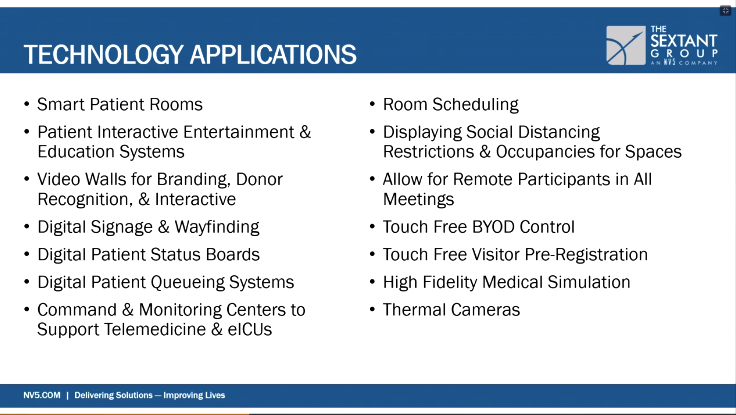
Glenn’s advice: Don’t start with the product; start with the business use case, then find the technology solution.
“Technology is the easy part; finding the business case … that ideal patient experience, is really the challenging piece. Figure that out first and the technology piece will be easy,” Glenn said.
He adds that it’s about the seamless experience that consumers, providers and patients want — from office to home and beyond. Glenn’s keynote was a well-thought-out, birds-eye view of the healthcare space as related to AV. This is a wide and exciting opportunity for integrators.
A Vendor Panel with SYNNEX Manufacturer Partners
In yesterday’s vendor panel, which included five SYNNEX manufacturer partners, we heard how each partner is using its strengths in AV to make waves in healthcare.

- NEC Display: Regarding the question of medical-grade equipment, Stan Swiderski of NEC added that it’s not always needed. He adds that 80% of displays in healthcare can be commercial-grade. NEC’s displays are widely used in healthcare environments in patient rooms, for general signage, as LED posters with built-in media players and more.
- LG: Dirk Paul of LG explained some of the great healthcare display innovations he’s seen — like medical monitors, lobby and reception solutions, long-term-care displays, desktop solutions and more. Central to each and every LG solution is enhancing the facility and improving the employee, resident and guest experience. Virtually any space can be transformed; it’s a matter of finding the right solutions to do it.
- Logitech: Discussing the topic of flexibility, Roseanne Cohen of Logitech added that the industry can leverage video collaboration to benefit both the patient and clinician — reducing in-person visits and, thus, costs. While you can find Logitech products integrated into so many products and used in some of the largest healthcare systems worldwide, you also have to look at the value of remote care in telemedicine as you’re weighing a solution. The technology has to be easy to adopt in the clinical workflow — it’s about convenience and the urgency of gaining access to the right care when and where it’s needed — whether in a physician’s office or a parking lot, Cohen added. It’s also about building trust and loyalty in that patient-provider relationship.
- Hikvision: When asked whether there are proactive steps organizations can take to keep people safe, Michael Martin of Hikvision explained there’s a current change in mindset that “this can happen again; this will happen again; how do we mitigate the risk that’s out there?” If you’re employing a COVID-centric solution now, Martin said, the importance/value of the technology solution, aiding in health and safety, will still be in effect in the future, even if we have a vaccine. Within Hikvision cameras, for instance, are analytics to monitor if people are wearing face masks, etc. We can monitor this data (per the parameter settings in the equipment) to shape our understanding — from a distance, that is.
- Ergotron: Mark Brandenhoff of Ergotron was asked, “How important is it for displays to be mobile/flexible in healthcare environments?” His response: when you think about how we operate today, with the unimaginable challenges we hadn’t seen in the past, a lot of systems were caught off-guard. Ergotron saw unprecedented demand in healthcare carts, for instance, as the need for flexibility and mobility has never been greater to operate safely and easily. Also from a telehealth standpoint, Ergotron has been able to work on its partnerships to provide solutions for mobile and thermal imaging.
SYNNEX’s ability to bring these partners together provides two-fold value — to both the reseller and the end user. These manufacturer partnerships help SYNNEX provide “total solutions,” Doar said. Bundled offerings are value-adds to resellers, giving them a higher-level view and the ability to bring in more solutions and partnerships. Ultimately, what’s all this about? Bringing better care to the patient and the community.
CARES Act Funding and Distribution Update
SYNNEX’s healthcare specialist, Tara Hutsell Brown, focuses primarily on opportunities within the healthcare space. Brown explained in her session that the healthcare market is one of the most regulated — driven by population growth and aging, nursing shortages, staff and patient safety, record storage and data management, regulatory compliance, budget control, cost reduction and technological changes.
“Telemedicine has progressed about 10 years in just three months,” Brown explained.
Telehealth utilization, mandated by the CDC, has increased nearly 400% since the start of COVID-19. Her assessment? Telemedicine is here to stay, citing these data points:
- 75% of hospitals are utilizing telehealth substantially above pre-COVID-19 levels. Ascension Saint Thomas saw 30,000 patients via telehealth in the past two months compared to only 50 patients in the month of February.
- 90% of all hospitals anticipate continuing to utilize telehealth post-COVID-19 according to the American Medical Association.
- Telehealth visits could account for $250 billion. That is approximately 20% of what is spent on outpatient and home health visits.
Related to the latest funding updates around the CARES Act, Brown showed us (as of July 3) the top 15 hospitals that received funds from the first round distributions — which does not include loans from the Paycheck Protection Program. These included The New York and Presbyterian Hospital, NYU Langone Hospitals, Long Island Jewish Medical Center, HMH Hospitals Corporation, Mount Sinai Hospital and more. According to Brown, many of these hospitals are allocating funds to telehealth equipment, devices and services.
Since the CARES Act was instituted, other proposals have shown up on the Senate floor to combat coverage restrictions. Proposed changes include allowing telehealth visits to be conducted via smartphones, patients living in any geographic area being able to receive telehealth services, and preexisting relationships between the physician and patient no longer being required.
Brown transitioned to touch on opportunities and some healthcare technology portfolio items out there — solutions you should be aware of even if you’re not working with SYNNEX.
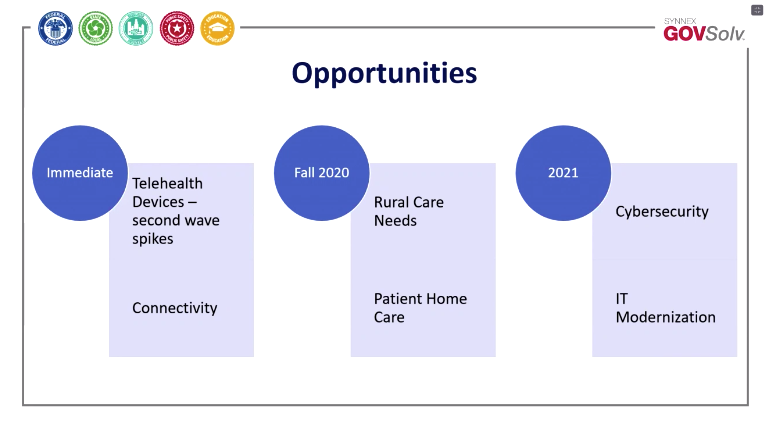
Lastly, Brown’s key takeaways:
- Hospitals and providers have already received funding, but healthcare funding is still available.
- SYNNEX has resources to assist with filing for funds, along with telehealth solutions available and in-stock — like antimicrobial point-of-care kiosks, solutions for remote patient monitoring, and medical carts and accessories.
- Telehealth solutions and thermal technology are, no doubt, in demand.
Learnings and a Vendor Toolkit
At the end of the live portion of yesterday’s event, attendees were introduced to a vendor toolkit — an online collection of resources from SYNNEX vendors supporting healthcare. Through the digital toolkit on the day’s page, attendees could watch videos, download collateral, chat with vendors and book Zoom video appointments with them.
We enjoyed covering this event. Devoting this day and a complete virtual event to the healthcare vertical is a fantastic start in better understanding the nuances of this space. In doing this, SYNNEX presented itself as a thought-leader and innovator in healthcare AV.
Perhaps, now, you’re really bummed you missed all this. I don’t blame you. Good news: You can still register to view the archived content.
Plus, we have the inside scoop — SYNNEX will soon be holding another day of fresh content in its second installment of SYNNEX VISUALSolv LAVNCH Days. SYNNEX VISUALSolv Education Day take place on August 6, with all-new thought-leadership and product information specific to the education vertical. Register here!



